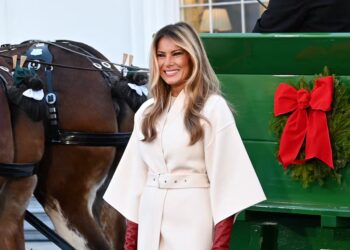President Trump said he had accepted an invitation from China’s leader, Xi Jinping, to visit Beijing in April. The entreaty came during a call between the two leaders on Monday morning, in which they discussed several areas of bilateral and geopolitical tension, including lackluster Chinese purchases of American soybeans, along with Ukraine and Taiwan.
The call took place several weeks after a summit between the leaders in South Korea, where officials agreed to a yearlong truce that has rolled back many of the tariffs Mr. Trump imposed on China, and the retaliatory measures Beijing took in return.
In a social media post on Monday afternoon, Mr. Trump said it was a “very good telephone call” that touched on Ukraine, China’s exports of chemicals used to make fentanyl and its purchases of farm products. He described the call as a “follow up to our highly successful meeting in South Korea” and said there had been significant progress on both sides in meeting those commitments.
“Now we can set our sights on the big picture,” Mr. Trump said. “To that end, President Xi invited me to visit Beijing in April, which I accepted, and I reciprocated where he will be my guest for a State Visit in the U.S. later in the year.”
In its readout, Chinese state media said on Monday that the leaders had discussed the situation in Ukraine, and that Mr. Xi had called for both countries to maintain the positive momentum in their relationship since the South Korea meeting.
State media also reported that Mr. Xi had “clarified China’s principled position” on Taiwan, a self-governing island that China lays claim to. Mr. Xi emphasized “that Taiwan’s return to China is an important part of the postwar international order,” state media said. Mr. Trump had previously said that Taiwan did not come up in the meeting in South Korea.
Although the United States and China have greeted the prospect of an economic truce, U.S. officials have appeared wary in recent weeks about whether all the promises made at the summit would be fulfilled.
Scott Bessent, the Treasury secretary, said this month that the United States and China were still working on details of an agreement that would guarantee the flow of valuable rare earth minerals from China. Beijing clamped down on exports of those products this year amid the trade clash, causing anxiety among automakers and other companies that need the minerals for their products.
U.S. and Chinese officials have also been at odds over China’s purchases of American farm goods. China halted purchases of American soybeans this year as trade tensions with the U.S. flared. After the meeting in South Korea, the Trump administration said China had agreed to resume purchases of American soybeans. The Chinese government, however, never specifically confirmed the details of that agreement.
Brooke Rollins, the agriculture secretary, said on CNBC on Monday that China has now bought about 1.5 million metric tons of soybeans since Oct. 1, a total that is far short of the 12 million metric tons that the Trump administration said the Chinese government has pledged to purchase by the end of the year.
“We’ve got a significant way to go,” Ms. Rollins said. “Every sign is that their commitment remains true.”
Ms. Rollins said that the terms of the deal with China still needed to be finalized. She also explained that the preliminary agreement did not demand that the soybeans were shipped by the end of the year, but that orders needed to be placed.
Amid the truce, the Trump administration has also been debating what kind of American A.I. technology to sell to China. Tech executives favor selling more advanced products to the country to try to keep Chinese companies from developing competing goods, but some Washington officials still see any effort to aid China’s A.I. industry as a national security threat.
In an interview on Bloomberg TV on Monday, Howard Lutnick, the commerce secretary in charge of technology export licenses, said that Mr. Trump was listening to various advisers with different opinions on the topic, and that the decision about whether to sell the H200, a more advanced chip made by Nvidia, was “on his desk.”
“He is going to weigh those decisions,” Mr. Lutnick said of the president. “He understands President Xi the best. He will decide whether we go forward with that or not.”
Kevin Draper contributed reporting.
Ana Swanson covers trade and international economics for The Times and is based in Washington. She has been a journalist for more than a decade.
The post Trump Will Visit China in April for Meeting With Xi Jinping appeared first on New York Times.




